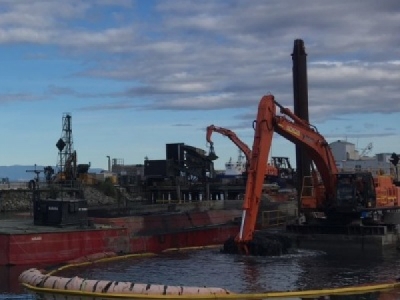
Posted on May 1, 2018
A NZ$8.9m project to remove and stabilise about 28,000 cubic metres of contaminated sediment using mudcreting technology was due to be completed at the Calwell Slipway at Port Nelson, New Zealand in April.
In addition to removing such contaminants as tributyltin (Tbt) and copper from sediment around the 1970-opened slipway, the project adds three to four metres’ depth to the surrounding basin. Furthermore, the treated dredged material is being used to create an adjacent 5,000-square-metre reclamation for log storage.
Heron Construction commenced site works in December 2017 in an operation that dredged sediment on to a barge and then loaded it into a wharfside mixing plant. There, the cement and powdered activated carbon were introduced to a specification developed by local engineering firm, Beca Group, and mixed into mudcrete. A dump truck was then used to mobilise the wet mudcrete from conveyors at the end of the mixing plant to the reclamation construction site, where the material was placed as fill with an excavator.
Port Nelson environmental officer Kelly Leonard says although mudcreting technology has “been around for a number of years”, she understood it was less commonly utilised as a remediation option for contaminated sites.
“Currently, I understand it is only being used by Port Nelson and Ports of Auckland in New Zealand,” Ms Leonard told Port Strategy.
“Many options were considered as part of the remediation options assessment but cost, available technology to manage the contaminants in the concentrations and volumes we had, remediation outcomes, and iwi’s [local Maori] desire to not see the contamination shipped off to become another region’s burden detracted from those options.
“Following a detailed options analysis (including cost/benefit) the only viable options left on the table were to do nothing or take the stabilisation and reclamation construction option forward.
“Doing nothing was definitely the cheaper alternative, but it did not remove the environmental risk this contamination posed from a receiving environment with high ecological value. Nor did it ensure the future viability of the Calwell Slipway and the marine engineering hub for Nelson that are reliant on safe navigable passage into the Calwell Slipway Basin.”
Ms Leonard observes that the contamination on the Calwell Slipway is a common problem in the wider port industry.
“Historically, and particularly prior to the Resource Management Act in New Zealand, there was no best practice around managing anti-fouling products and vessel cleaning. Tbt is one of the most toxic substances knowingly introduced into the marine environment and as such, has had a worldwide ban on its use.
“I can see this project, and this remediation option, being used as an attractive example for other facilities faced with a similar problem, for a similar suite of reasons that we chose it.”
Source: Port Strategy





